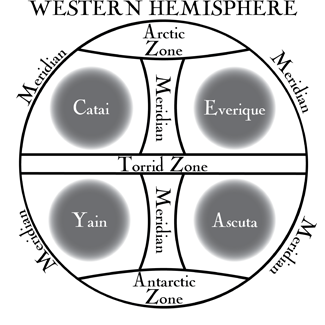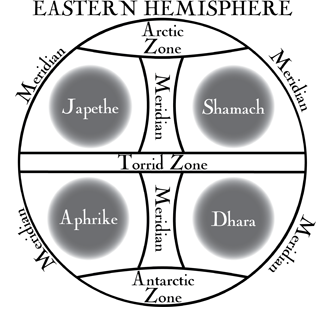The World of Corthus
Corthis
The world of Corthis sits at the center of existence. The sun, moon, stars, and planets all orbit around the world. Natural philosophy, which includes geography, geology, and meteorology, has long held that Corthis is spherical. Geoffrey Hawkins confirmed this theory when he circumnavigated the globe in 1442.
The sun's daily path around the middle of the world has scorched the earth with its heat and created a torrid zone at the equator. The poles of the world are far from the sun's heat and form arctic zones where everything is perpetually bound ice. Between the torrid and arctic zones are the temperate zones, which are capable of supporting life. While the torrid zone separates the northern temperate zone from the southern, the four meridian oceans run from pole to pole and divide each of the temperate zones into four smaller regions. Philosophers from Japethe have long suspected that each of these regions holds a continent to maintain the metaphysical balance of the world, making for a total of eight continents on Corthis.


Everique
Everique is a continent in the northern temperate zone of Corthis. It is separated from Japethe by the Levian Ocean on the east and bordered on the west by the Iyonic Ocean. Two mountain ranges stretch from north to south, dividing the continent into thirds. The mountains are high and imposing in the north before dwindling as they march to the south, where they become little more than rugged hills when they reach the southern coast. The western coast of Everique is said to be miles of dense temperate rain forest. Enormous lakes that could be considered small seas dominate the heartland of the continent. The eastern coast of the continent is heavily forested in the north with extensive marshes in the south.
Stephan Walsch crossed the Levian Ocean and landed on southwestern Everique (or Everlund in the Kennard tongue) in 1416. His voyage triggered the Age of Discovery when countless expeditions left Japethe to explore and colonize the new land. For nearly two hundred years, Japethan explorers sailed the coasts of the continent and used its many rivers to delve into the interior. Guiern, Saronne, Morante, Kleef, and the Freeports of the Kennard Reach all established colonies. Many of the colonies failed, but the waves of colonization continue to the present day and settlements now dot the eastern coastline. The largest of the colonies is Aradie, founded by Saronne, but the Kleefish colony of Meerpelt is growing quickly.
Everique was not uninhabited when Walsch made his voyage. Countless native tribes call the continent home. Most of the tribes on the eastern coast live as hunters and gatherers and do not have the technology to support large populations. These tribes are small and disorganized, and their interactions with the settlers vary greatly. The tribes that live near the lakes and along the rivers of the heartland are much more advanced. They have cities, and their numbers discourage Japethan settlement in the interior. There are tales of an empire that stretches along the west coast of Everique, but explorers to that land come back empty-handed or they don't come back at all.
Japethe
Japethe is a continent in the northern temperate zone of Corthis on the eastern side of the Livian Sea. To the north, the land fades into the ice-bound wilderness of the Uttermost North, and the continent narrows in the east to an isthmus where it connects with the western wastelands of the continent Shamach. To the south is the shallow and tame Mezinne Sea which separates Japethe from the vast deserts, savannas, and empires of Aphrike.
Japethe is a continent of great mountain ranges and many winding rivers. The Whitecrest Mountains, the largest of the continent's many mountain ranges, curves in a great arc across the interior of Japethe. The range is almost impassible in the west, but it slowly dwindles as it arcs to the east, eventually breaking into two ridges that peter out into the plains of Vaspaar. Steady rainfall from storms blown in from the Levian Ocean provides abundant moisture, while cloaking the westernmost islands in near perpetual mists. Great peninsulas, separated by narrow bays, dominate the southern shoreline of Japethe. The northern coastline is extremely boggy and miles of land can vanish under the ocean when the tide comes in only to rise again as the water recedes.
Japethe is the most recently civilized of the continents of the Old World and its nations are young and vibrant. Each country has a patron great spirit, whose personality and dictates greatly influence the character of each nation. The sole exception is Aileon, whose great spirit vanished several hundred years ago. The great spirits and nations of the north tend to be aggressive and warlike, while those in the south are more cerebral and cultured. The nations of Japethe are currently undergoing a philosophical and economical revolution, causing rapid development in the sciences and encouraging explorers to travel to the far reaches of Corthis in search of spices, wealth, and the unknown.
Torrid Zone
The Torrid Zone (sometimes called the Tropics) encircles the world of Corthis at its equator. This region is defined as the region of the globe in which the sun passes directly overhead at some point of the year. The Torrid Zone is bounded on the north by the Tropic of Cancer and in the south by the Tropic of Capricorn.
For the longest time, philosophers believed that the Torrid Zone was all but uninhabitable. The nearness of the sun to Corthis at the equator causes inhospitable deserts, dense jungles, and trackless swamps. Insects and animals are aggressive, disease is rampant, and the fierce sun burns the skin of the inhabitants until they are black as ash. This intimidating region is the subject of many Japethan legends, including that giants with nails of iron and hair of flame live at the heart of the Torrid Zone.
In recent years of the Age of Discovery, philosophers have begun to question long-held assumptions about the Torrid Zone. While the region is challenging, it is not as dire as the early philosophers warned. Many great civilizations have arisen in the Tropics and have thrived, despite the insects, predators, and heat, and explorers have yet to find any giants.
« Return to the Almanac Index

